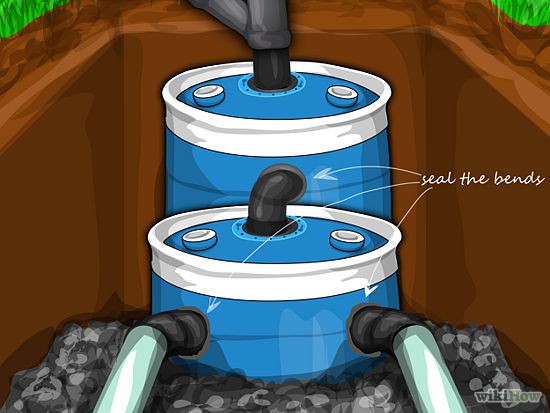In just about any situation, this type of septic situation is illegal and if you get caught installing or using it, you will be fined, likely have to remove it and perform environmental mitigation actions to ensure there is no contamination.
In a dire circumstance, though, the rules that govern septic systems will be the last thing on anyone's mind and if you find yourself in that type of situation, this type of system could be critical to maintaining your health.
How to Construct a Small Septic System
Property owners planning a system similar to this one should be aware that this system would not pass muster with any public health department in the USA and could subject the owner to a hefty fine if the system was discovered in use.
Dig a ditch 4 feet wide, 26 feet long, and 3 feet deep.
Cut a hole in the top of each drum the size of the toilet flange pipe outside measurement. It should be near the edge. A saber saw is best for this task.
Attach a 4″ toilet flange to each hole.
Cut two holes in the top side of the lower drum, as shown in the photo, 45 degrees away from a perpendicular line drawn from the hole on top to the far side.
Cut one hole in the upper drum opposite the hole in the top, as shown in the photo.
Place the drum with one hole in the side at the end of the trench. Level the drum. The top of the drum should be at least 4 inches below grade.
Dig a hole about one foot deeper for the placement of the second drum in front of the first.
Dig the hole mentioned in step 8 a little deeper and fill with gravel until the 90 ell fits perfectly from the hole in the side of the top drum to the toilet flange of the lower drum.
Cut a 3 1/2″ piece of 4″ ABS pipe (nipple) and glue it into one end of the 90 ell. Cut another nipple about 2 1/2″ long and glue it in the other end.
Test the fit for alignment between the two drums. The end with the short nipple should go into the upper drum.
When you are sure about the fit, glue the end of the 3 1/2″ nipple into the toilet flange.
Glue a “Y” to 3 1/2 nipples and add a 45 degree bend to the left side of the “Y”. Align the “Y” to meet the incoming waste line, and glue it into the toilet flange.
Cut and glue (2) 2 1/2″ nipples to the remaining two 45 degree bends at one end only and insert into holes in the side of the lower drum.
Pound a stake into the ground so that the top of the stake is level with the bottom of the 45 degree bend coming out of one side of the bottom drum.
Tape a 1″ wide block to the end of a 4 foot level.
Start the second stake a little less than 4 feet down the trench from the first.
Lay the end of the level without the block on the first stake and the block on the second. Pound the stake down until the level shows level when the block is on the second stake. The second stake is now 1″ lower than the first, or 1/4″ per foot.
Repeat this process until you have stakes the length of the trench.
Place the gravel in the trench until the gravel is equal with the top of the stakes.
The gravel should now slope away from the drums at 1/4″ to the foot.
Place two pieces of 10 foot 4″ perforated drain pipe connected with a slip coupler (holes down). Slide one end into the 45 degree bend of the lower drum. Repeat on the other side.
Check the drain pipes with the level and block to see if the 1/4″ grade is consistent along the length of the pipe. Adjust by adding or removing gravel under the pipe.
Seal the 45 degree bends and the 90 degree bend to the lower and upper drums, respectively. Try a two part epoxy. You could also use silicon caulk. Consider using flex pipe for this, so that if the ground shifts it will give a little.
Bury the trench to the top of the bottom drum with the remaining gravel.
Lay landscape fabric over the gravel. This will prevent the soil from seeping into the gravel.
Fill the remaining trench area with soil, compacting well to the original grade.
Fill the upper drum with water.
This type of system would be critical to keeping you and your family safe, but in all other scenarios, this is not an option because of the rules involved with septic systems.
To see a list of the materials as well as tips for building this safely and effectively, please visit Off Grid.
